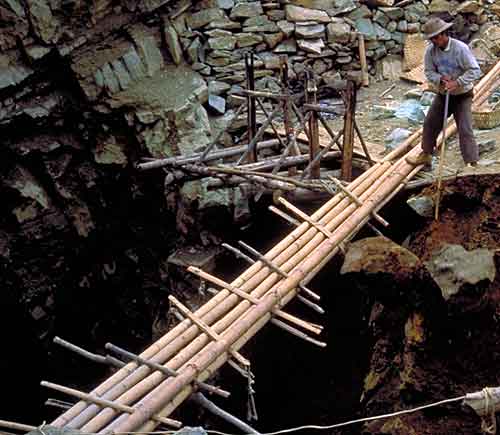|

By Richard
W. Hughes
Introduction/Name
Peridot
is one of the prettiest of all green gems, occurring in a color that
is the epitome of grass green. Interestingly enough, the name topaz
may have initially been applied to peridot, for it is found on the
island of Topazos (Zabargad) in the Red Sea.
 The
name peridot is used to describe the gem variety
of the forsterite to fayalite olivine series. The
name peridot is used to describe the gem variety
of the forsterite to fayalite olivine series.
 |
| Two magnificent examples of peridot. The
cut stone at left is an incredible 172.53 cts. Thee crystal
at right is equally rare. Both are from Pakistan. Stone:
Pala International; crystal: William Larson collection. Photo:
Jeff Scovil |
|
Color
Peridot
is ideochromatic, being colored by the ferrous iron that is basic
to its composition. The ideal color is a rich grass-green, but some
peridot is yellowish green, greenish yellow or brown. The best colors
of peridot generally contain about 10–15% of iron.
Lighting
Peridot
is not as light dependent as red and blue gems. It tends to look good
under all lights.
 |
| Two different peridots, illustrating the
importance of clarity. The stone at left is heavily included,
while that at right has far better clarity. Photo: Robert
Weldon |
|
Clarity
Since
peridot is not a particularly expensive stone, eye-clean clarity is
the standard. Burmese gems are often marred by small platelet inclusions,
which may give some stones a sleepy appearance. The strong birefringence
(0.036) of peridot can also give stones a slightly sleepy look. This
is most pronounced in large stones (10 cts. plus).
Cut
Only
imagination limits the cuts and shapes applied to peridot, with everything
from stunning fantasy cuts to tumbled beads being seen. Again, because
it is not terribly expensive, cutters can focus on beauty more than
weight retention. This means that good cutting, proportions and symmetry
are to be expected. Stay away from misshapen native cut gems, unless
they are cheap enough to recut to good proportions.
 |
No OSHA in
Burma. A peridot miner at Pyaung Gaung, in Burma’s
Mogok Stone Tract.
Photo: Richard Hughes |
|
Prices
Peridot
ranges in price from about $50–80/ct. for well-cut gems in
the 1–2 ct. size, up to as much as $400–450 ct. for large
fine gems of top color.
Stone
Sizes
Peridot is common in sizes ranging from melee
to faceted stones of 10 cts. or more. Fine faceted stones of
greater than 300 carats are known, but quite rare.
Sources
Gem
peridot has been found in a handful of places around the world. In
large sizes (10 cts. plus), Pyaung Gaung in Burma’s Mogok Stone
Tract is most important. Faceted gems of hundreds of carats are known
from this deposit. In the 1990’s, a new deposit from Pakistan’s
Suppatt region was discovered, and this material is every bit the
equal of that from Burma.
 In the US, the San Carlos Apache Indian Reservation supplies good material,
but this rarely cuts gems above 10 cts. Peridot is also mined in China,
Brazil, Australia and Norway, among other places. The historic deposit
of Zabargad has not produced at all in decades. In the US, the San Carlos Apache Indian Reservation supplies good material,
but this rarely cuts gems above 10 cts. Peridot is also mined in China,
Brazil, Australia and Norway, among other places. The historic deposit
of Zabargad has not produced at all in decades.
Enhancements
Peridot
is not typically enhanced.
Imitations
Peridot
has never been synthesized, but a number of imitations exist, including
natural stones such as tourmaline, and man-made imitations such as
glass. Green glass is the most common imitation, and can be easily
separated by its single refraction.
Properties
of Peridot
| Composition |
Peridot
is the gem variety of the olivine group, which has the following
species:
Forsterite – Mg2SiO4
Fayalite – Fe2SiO4 |
| Hardness
(Mohs) |
6.5
to 7 |
| Cleavage |
Imperfect
to distinct in one direction (rarely seen) |
| Specific
Gravity |
3.34
+ 0.17, – 0.07 |
| Refractive
Index |
1.654–1.690 (±0.020) |
| Birefringence |
0.035 to 0.038 |
| Optic
Character |
Biaxial (positive
or negative; the beta index is usually near halfway between alpha
and gamma) |
| Crystal
System |
Orthorhombic;
usually occurs as rounded pebbles; well formed crystals are quite
rare |
| Colors |
Mainly green; sometimes yellow or brown |
| Pleochroism |
Weak to moderate,
dichroic |
| UV
Fluorescence |
Generally
inert |
| Dispersion |
0.020 |
| Phenomena |
Cat’s
eye and star peridot are known, but are rare |
| Handling |
Ultrasonic: not
safe; never clean peridot ultrasonically
Steamer: not safe
The best way to care for peridot is to clean it with warm, soapy
water. Avoid exposure to heat, acids and rapid temperature changes |
| Enhancements |
Peridot
is not typically enhanced |
| Synthetic
available? |
No |
Further Reading:
The Collector Gem Buying Guides
In addition to the above, please visit the Learning
Vault at Palagems.com for many additional articles on gems, minerals and mining.
|





